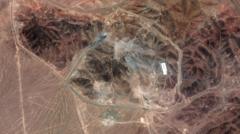Reporting from The Hague, CIA Director John Ratcliffe has asserted that recent military strikes by the United States have "severely damaged" Iran's nuclear facilities, significantly delaying its nuclear program's progress. This claim runs counter to a leaked preliminary report from a Pentagon intelligence agency, which indicated that critical components of Iran's nuclear capabilities remained unharmed post-bombing and merely set back their progress by a few months.
In a recent social media address, President Donald Trump supported Ratcliffe's assessment, emphatically stating that the strikes "obliterated" key facilities and labeled media reports suggesting otherwise as "fake news." As anticipation builds, Trump is expected to engage in talks with Iran next week, aiming to negotiate a halt to its nuclear endeavors.
The U.S. operation targeted three principal Iranian nuclear sites using 125 military aircraft. Emerging satellite imagery demonstrates significant damage, including multiple craters at the Fordo and Isfahan facilities. However, questions regarding the extent of the destruction remain, particularly concerning subterranean installations.
Director of National Intelligence Tulsi Gabbard backed the CIA's findings, asserting that Iran would face years of rebuilding should they attempt to reestablish the damaged facilities, specifically Natanz, Fordo, and Esfahan. Nonetheless, initial evaluations from the Pentagon were delivered with "low confidence" and indicated that much more analysis is required, hinting at internal division within U.S. intelligence assets regarding the efficacy of the strikes.
Iranian officials have acknowledged the damage to their nuclear facilities but maintain that their program is solely peaceful. The complex interplay of communication between the U.S. and Iranian entities, reported by Middle East envoy Steve Witkoff, continues to unfold against a backdrop of fluctuating tensions in the region.
As this narrative develops, the international community watches closely, particularly in light of statements from the Israeli Atomic Energy Commission regarding the substantial impact on Iran's nuclear timeline. The situation remains fluid as diplomatic ties and military strategies shift in this volatile landscape.
In a recent social media address, President Donald Trump supported Ratcliffe's assessment, emphatically stating that the strikes "obliterated" key facilities and labeled media reports suggesting otherwise as "fake news." As anticipation builds, Trump is expected to engage in talks with Iran next week, aiming to negotiate a halt to its nuclear endeavors.
The U.S. operation targeted three principal Iranian nuclear sites using 125 military aircraft. Emerging satellite imagery demonstrates significant damage, including multiple craters at the Fordo and Isfahan facilities. However, questions regarding the extent of the destruction remain, particularly concerning subterranean installations.
Director of National Intelligence Tulsi Gabbard backed the CIA's findings, asserting that Iran would face years of rebuilding should they attempt to reestablish the damaged facilities, specifically Natanz, Fordo, and Esfahan. Nonetheless, initial evaluations from the Pentagon were delivered with "low confidence" and indicated that much more analysis is required, hinting at internal division within U.S. intelligence assets regarding the efficacy of the strikes.
Iranian officials have acknowledged the damage to their nuclear facilities but maintain that their program is solely peaceful. The complex interplay of communication between the U.S. and Iranian entities, reported by Middle East envoy Steve Witkoff, continues to unfold against a backdrop of fluctuating tensions in the region.
As this narrative develops, the international community watches closely, particularly in light of statements from the Israeli Atomic Energy Commission regarding the substantial impact on Iran's nuclear timeline. The situation remains fluid as diplomatic ties and military strategies shift in this volatile landscape.






















